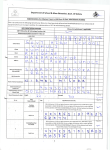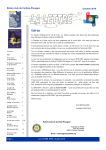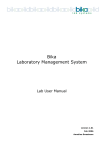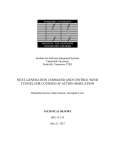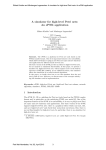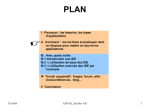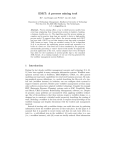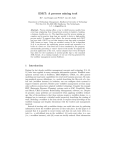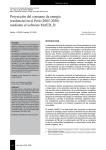Download User Manual
Transcript
User Manual
“Privacy Infringement Severity”
ProM Plug-in
Author: Sebastian Banescu
Version: 0.1
1
Table of Contents
1. Introduction..................................................................................................................... 3
1.1 Implementation Details.............................................................................................3
2. Installation...................................................................................................................... 3
3. Plug-in inputs.................................................................................................................. 4
3.1 Event Logs...............................................................................................................4
3.2 CPN Models.............................................................................................................5
3.3 Privacy Weights.......................................................................................................6
3.4 User Reputation.......................................................................................................7
3.5 Task and Role Distance...........................................................................................7
3.6 Configuration file......................................................................................................7
4. Step-by-step tutorial........................................................................................................9
5. Plug-in outputs.............................................................................................................. 11
5.1 XML File................................................................................................................. 11
5.2 Scatter Plot............................................................................................................. 13
2
1. Introduction
This document describes how the “Privacy Infringement Severity” ProM plug-in, hereafter called
just “the plug-in”, can be installed and used. The plug-in was developed as an aid for privacy
auditors to help with the prioritization of privacy infringements depending on their severity.
Privacy infringements are detected by replaying an audit log over a business process model. A
more detailed description of the technique was presented by Banescu, Petknovic and Zannone
[2].
1.1 Implementation Details
We implemented the proposed privacy infringement identification and quantification technique
as a plug-in in the ProM 6 framework1. ProM is an extensible framework that supports a broad
range of process mining techniques in the form of plug-ins. The plug-in requires two inputs (an
event log and a CPN model) and gives two outputs (an XML file describing all deviations of the
event log from the process model and a scatter plot illustrating the severity of the privacy
infringements).
The plug-in uses the Access/CPN framework [3] to interact with the CPN Tools simulator.
Access/CPN provides two interfaces: one written in the Standard ML and another written in the
Java programming language. In the implementation we used the latter interface since it can be
easily integrated with the ProM framework, which is also written in Java. The Java interface of
Access/CPN provides object-oriented abstractions for all the building blocks of CPN models
(i.e., transitions, places, arcs, etc). The interface also facilitates loading a CPN model from a file
created using CPN Tools and provides an object-oriented interface to the CPN model simulator.
2. Installation
This section describes the steps needed to install the plug-in. ProM contains many process
mining related plug-ins, however, the “Privacy Infringement Severity” plug-in is not part of the
official ProM release. Therefore, the plug-in has to be used as an Eclipse project via SVN. Here
is a step-by-step tutorial for plug-in installation:
1. Download and install Eclipse from http://www.eclipse.org/
2. Install the Subclipse, SVN plug-in for Eclipse from http://subclipse.tigris.org/
3. From your Eclipse environment, make a new SVN project. Right-click on the Package
Explorer tab, select New -> Other… and then choose “Checkout Projects from SVN”
under SVN folder and then click “Next”
4. Create a new repository location using the following URL:
https://subversion.assembla.com/svn/privacy-infringement-severity/
5. Select the repository you just created and click “Next”
6. Choose the “trunk” folder from the repository and click “Finish” and wait for the download
to finish
1
3
http://www.processmining.org/prom
7. Now you should have a new project called “Privacy” inside your “Package Explorer”
8. To run the package, right click on the “ProM with UITopia (Privacy).launch” inside the
newly created project, and select Run As… -> ProM with UITopia
9. The first time ProM starts you need to be really patient until it initializes, it may take a
few minutes.
3. Plug-in inputs
This section describes the format of all inputs used by the plugin. It also provides some
guidelines on how some of these inputs can be created.
3.1 Event Logs
The input event logs need to follow the extensible event stream (XES) format1. ProM offers
native support for log files that comply with the XES standard. The plug-in uses the OpenXES 2
library for processing event logs.
The particular XML schema that needs to be implemented by the event log files is:
<xs:schema attributeFormDefault="unqualified" elementFormDefault="qualified"
targetNamespace="http://www.xes-standard.org/"
xmlns:xs="http://www.w3.org/2001/XMLSchema">
<xs:element name="log">
<xs:complexType>
<xs:sequence>
<xs:element name="trace">
<xs:complexType>
<xs:sequence>
<xs:element name="string">
<xs:complexType>
<xs:simpleContent>
<xs:extension base="xs:string">
<xs:attribute type="xs:string" name="key"/>
<xs:attribute type="xs:string" name="value"/>
</xs:extension>
</xs:simpleContent>
</xs:complexType>
</xs:element>
<xs:element name="event" maxOccurs="unbounded" minOccurs="0">
<xs:complexType>
<xs:sequence>
<xs:element name="string" maxOccurs="unbounded" minOccurs="0">
<xs:complexType>
<xs:simpleContent>
<xs:extension base="xs:string">
<xs:attribute type="xs:string" name="key" use="optional"/>
<xs:attribute type="xs:string" name="value"
use="optional"/>
</xs:extension>
</xs:simpleContent>
1
2
4
http://www.xes-standard.org
http://code.deckfour.org/xes
</xs:complexType>
</xs:element>
</xs:sequence>
</xs:complexType>
</xs:element>
</xs:sequence>
</xs:complexType>
</xs:element>
</xs:sequence>
</xs:complexType>
</xs:element>
</xs:schema>
A very short example of a log file containing one trace with one event is:
<?xml version="1.0" encoding="UTF-8" ?>
<log>
<trace>
<string key="concept:name" value="Run 1"/>
<event>
<string key="concept:instance" value="Top.Alice.Authenticate_Patient{ demogr =
"Smith" }"/>
<string key="org:resource" value="Alice"/>
<string key="org:role" value="Receptionist"/>
<string key="concept:name" value="Authenticate Patient"/>
</event>
</trace>
</log>
Note that a log may contain several traces and a trace may contain several events. Moreover,
all the attributes listed in the example are used by the plug-in and have to be set in any log file
that is provided as an input.
Description of attributes:
● concept:instance - represents the binding recorded by CPN Tools during simulation; it
includes the hierarchical data regarding the location of the executed transition and the
data items used during the execution.
● org:resource - represents the user name
● org:role - the role held by the user during execution
● concept:name - the name of the transition
3.2 CPN Models
CPN Tools1 provides a mature environment for constructing, simulating, and performing
analysis of CPN models. A tutorial on building CPN models using CPN Tools is out of the scope
of this document. The reader is referred to the CPN Tools website for such purposes.
A screen shot of CPN Tools with a CPN model containing multiple modules on different pages is
presented in the figure below.
1
5
http://cpntools.org/
The guideline for designing CPN models are the following:
● Add all the transitions belonging to a role on a single page labeled with the
corresponding role name
● The communication between all pages representing user roles has to be done through
input/output ports via a page labeled “Top”.
● The “Top” page will contain only substitution transitions corresponding to the roles,
where each such substitution transition has to be labeled with a user name.
3.3 Privacy Weights
The file containing information about the sensitivity of data items must follow a simple text
format. Every line from this file must contain the identifier of the data item and a positive integer
number indicating its sensitivity, separated by a blank space. An example of such a file is
presented next:
id 3
demogr 2
med_hist 10
diag 8
date 1
email 2
sno 7
prescr 6
insurance 2
account 10
nodata 0
Note that the same identifier names have to be used on the CPN model arcs and for the
concept:instance attribute in the log files.
3.4 User Reputation
6
The file containing information about the user reputation levels follows a similar format to the
previous file, except that each line contains a user identifier and a real number between 0 and 1
indicating that user's reputation level. An example of such a file is presented next:
Alice 0.5
Bob 0.9
Charlie 0.6
Mallory 0.1
none 1
3.5 Task and Role Distance
The file containing information about the similarity distance of the tasks also follows a simple
text format, however, its structure is different. The first line consists of a list L of all the task
identifiers separated by blank spaces surrounded by brackets. The following |L| lines form an |L|
x |L| matrix of real numbers. Each element of the matrix mi,j indicates the similarity between
tasks Li and Lj. An example of a file containing a 4 by 4 matrix is presented next:
(Authenticate Patient) (Schedule Appointment) (Compute Expences) (.)
0.0 0.8 1.0 1.0
0.8 0.0 0.8 1.0
1.0 0.8 0.0 1.0
1.0 1.0 1.0 1.0
The file containing information about the similarity of roles has the same format as the previous
file. An example of a file containing a 4 by 4 matrix is presented next:
Receptionist GP LabTechnician .
0.0 0.8 0.6 1.0
0.8 0.0 0.5 1.0
0.6 0.5 0.0 1.0
1.0 1.0 1.0 1.0
Note that for the second files the role names are not surrounded by brackets. However, role
names composed of several words are written together. For experimental purposes the Matrix
comparison tool provided on the Colorado University Boulder website1 was used.
3.6 Configuration file
The configuration file (“config.txt”) has to be placed in the working directory and it contains 5
constant values that are used by the privacy metric and 4 paths to default input files.
The privacy metric which this plug-in is based on was developed by Banescu and Zannone [1]
and its analytical formula is presented next:
where:
●
●
1
7
- represents the activity that should have been executed according to the business
process specification
- represents the log event that indicates the activity that was actually executed by the
user
http://lsa.colorado.edu/
●
- are constants that are used to tune the metric (these constants
can be set in the configuration file “config.txt”)
●
- represents the reputation of the user
●
- represents the similarity of the role held by the user and the role that should have
executed
●
- represents the similarity of the task that was executed to the task that should have
been executed
●
- represents the privacy penalty due to unauthorized access to data items. It is
actually the sum of privacy weights corresponding to the data items that were accessed
and should not have been accessed by the user during the execution of the activity from
event .
The rationale of this metric is that the role distance, task distance and sum of privacy weights
determine the severity of the infringement. The relevance of these factors on the severity is
determined by constants ,
and
, respectively. The reputation of the user performing the
activity scales the effects of all other inputs. The constraint
is needed to capture the
infringement when a user with high reputation ( = 1) deviates from the specification. Intuitively,
the reason for including all combinations between the privacy factors in the previous equation,
prevents the quantification from being nullified in case one of the factors is zero.
Indicating the privacy weights, user reputation, task and role distances each time you run the
plug-in may be tedious because most likely you will use the same files for several different logs
and CPN models. That is why the default values for these 4 files can be set in the configuration
file. An example of such a file is presented next:
1.1
1.0
1.0
1.0
1.0
taskSimilarity.txt
roleSimilarity.txt
reputation.txt
privacyWeights.txt
Note that the first five lines of the file contain the values for constants
,
respectively
. The following 4 lines contain the file paths relative to the eclipse project directory (absolute
path may also be given) for the task similarity, role similarity, user reputation respectively
privacy weights input files.
4. Step-by-step tutorial
This section describes and illustrates how to load the inputs and run the plug-in. When you start
ProM and go to the “Workspace” tab (left-most tab in the center), you will be able to see an
“Import” button in the top-right corner of the window. You will have to click that button and import
the event log and the CPN model that will be used by the plug-in. The following figure shows
how to load the CPN Model:
8
Note that the file type has to be “CPN Tools model”, otherwise the plug-in does not work. The
next figure shows how to import the log file:
Note that the file format can be any of the XES native formats supported by ProM. However it
needs to follow the event log schema and guidelines presented in the previous section. The
next step is to move to the “Actions” panel of ProM (the middle tab at the top) and find the
“Privacy Infringement Severity” plug-in in the list of actions. And then select the two previously
imported items in the left side-bar called “Inputs”. Selection is done by double-clicking an input
placeholder and then double-clicking the desired resource from the pop-up window. The next
figure shows the plug-in with the two inputs already selected:
9
The next step is to run the plug-in by clicking the “Start” button on the lower-right side of the
action list. This will trigger an input dialog to be displayed as shown in the following figure:
This dialog is used to provide the paths to the 4 text files containing the:
● Privacy weights;
● User reputation levels;
● Task distances;
● Role distances.
After providing the paths to these files click the “Finish” button in the lower-right corner to trigger
the execution of the plug-in.
5. Plug-in outputs
10
The execution time of the plug-in varies with the size of the CPN model and specifically the
number of XOR-gates in the model. Naturally the size of the event log is also a very important
factor that determines the execution time. After execution is finished two outputs will be given:
● an XML file describing all deviations of the event log from the process model;
● a scatter plot illustrating the severity of the privacy infringements.
5.1 XML File
One output of the plug-in consists of several sets of deviation lists for each trace in the event
log. Each log trace is analyzed by the privacy conformance checking algorithm against each
sub-model output by the algorithm. Therefore, one set of deviation lists is associated to each
pair of log trace and sub-model. A set of deviation lists consists of one or more deviation lists.
Each deviation list comprises of zero or more deviations and the quantification of the privacy
infringement. A deviation is described by its type, activities and events it involves. The
quantification of the privacy infringement is a positive real number computed per deviation list by
summing up the quantification of all the individual deviations in that list. The format of the output
follows an XML tree-structure which is visualized using the JTree GUI widget from the Java
Swing toolkit. A screenshot of the visualization is presented in the following figure:
11
5.2 Scatter Plot
12
Another output of the plug-in consists of a scatter plot as illustrated in the following figure:
The horizontal axis of the plot represents the traces from the event log. The vertical axis
represents the severity of the privacy infringement. Every sub-model output by the preprocessing phase is associated with a data series represented by a distinctly colored mark.
Each data series consists of $k$ values, where $k$ is the number of traces in the event log.
Every value from a data series is computed by taking the mean of the privacy infringement
quantifications of all deviation lists from the deviation list set associated with a trace and submodel pair. For the implementation of the scatter plot visualization the JFreeChart1 Java library
was used.
1
http://www.jfree.org/jfreechart
13
Bibliography
1. Banescu, Sebastian, and Nicola Zannone. "Measuring privacy compliance with process
specifications." Security Measurements and Metrics (Metrisec), 2011 Third International
Workshop on 21 Sep. 2011: 41-50.
2. Banescu, Sebastian, Milan Petković, and Nicola Zannone. "Measuring Privacy
Compliance Using Fitness Metrics." Business Process Management (2012): 114-119.
3. Westergaard, Michael, and Lars Kristensen. "The access/CPN framework: a tool for
interacting with the CPN tools simulator." Applications and Theory of Petri Nets (2009):
313-322.
14














